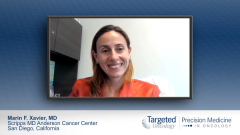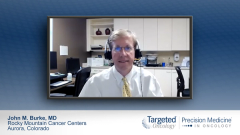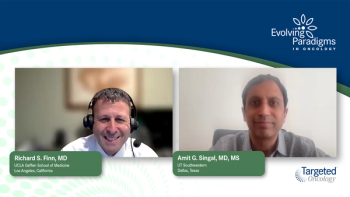
R/R DLBCL: Treating Fit Patients Who Are Transplant Eligible
Recommendations for approaching patients with relapsed/refractory diffuse large B-cell lymphoma with newer targeted treatment approaches as frontline therapy vs referral for transplant.
Episodes in this series

Marin F. Xavier, MD: When you have a patient who’s fit who has relapsed, the million-dollar question is, do you refer over and try to avoid CD19? Obviously, for relapsed large cell lymphoma, you don’t have a lot of time to get referrals. Oftentimes they need to be treated right away. In fit patients, do you go with an R [rituximab]–salvage chemotherapy approach until you know if they’re going to get CAR [chimeric antigen receptor] T cells or auto transplant? How is your clinical pathway for a fit patient with relapse large cell?
John M. Burke, MD: Historically, I’ve administered salvage chemotherapy. For fit, transplant-eligible patients, I’ve initiated the salvage chemotherapy, and then I get on the phone. I’m not a transplanter, so I do refer those out. I’ve gotten on the phone and arranged for a referral to a transplanter. That’s how it has worked in my practice. I’ll deliver the salvage chemotherapy, typically R-ICE [rituximab, ifosfamide, carboplatin, etoposide], arrange for them to see the transplanter, and have that ready to go if they’ve achieved a response after a couple of cycles.
It will be interesting to see how the world changes because we have in press release form only that 2 of 3 trials, comparing CAR T in the second-line setting with salvage chemotherapy and transplant, have improved event-free survival. What will be interesting is seeing those data at an upcoming meeting. Then also teasing out why did 2 of them work, but not the third 1? How should we all be practicing in the second line? Assuming that the decision is made that the best way to go is CAR T-cell therapy as a second-line therapy instead of salvage chemotherapy and transplant, a lot of questions come up. How are we going to get everyone to that? Do we have enough CAR T-cell centers to do that for the patients we have? Are there a lot of patients who won’t be able to travel to a center for CAR T-cell therapy, and can we expand CAR T-cell therapy and make it more widely available? What do you do after that? The experiences of patients who relapse after CAR T can be hard to treat. A lot of times they have cytopenias that prevent further therapy or make further therapy more difficult. What becomes your best third-line therapy after CAR T cells? There are a lot of questions, and the field may change dramatically in the next year as we see some data emerge. It’s a very exciting time.
Marin F. Xavier, MD: At the ICML [International Conference on Malignant Lymphoma], they did report out the ZUMA-7 and BELINDA trials for the second line.
John M. Burke, MD: Got it.
Marin F. Xavier, MD: ZUMA-7 would be for the Kite product, and BELINDA for Novartis. Maybe it’s because I’ve been doing lymphoma for 20 years, but I get this gut feeling when I know that a salvage transplant is not going to cure someone. What goes through my mind is, how long did they have their remissions? If it’s truly chemo-refractory disease, I try to push my patients onto those trials. We’re lucky to have centers that we partner with that offer them. Or do we fudge it, give a bridge, and then call it standard third-line therapy? If I know somebody is not going to be cured with high-dose chemotherapy and stem cell rescue, I find myself in that situation a lot: the bad ones recur soon after their frontline therapy or double or triple hits. I’m trying to get them on a fast track to cellular therapy. I work within a transplant group, but I don’t do transplant anymore. It’s still hard to get authorization for CAR T. It’s easier to do an auto transplant, especially if they’re Medicare. Most of our patients are Medicare, so there are financial barriers. They changed some of the reimbursements for that a year ago. It should make it easier, but it’s not easy to get it coordinated. Very few patients end up getting CAR T in any setting.
John M. Burke, MD: That’s an important point for practitioners to realize. It takes awhile to get it set up, to get them referred and get the insurance authorization. Most people by now have some experience with that and the delays. In a rapidly progressive disease, that can turn out not so well. When you have a patient with relapsed large cell lymphoma, getting on the phone early with your transplant CAR T-cell provider is important.
Transcript edited for clarity.







































